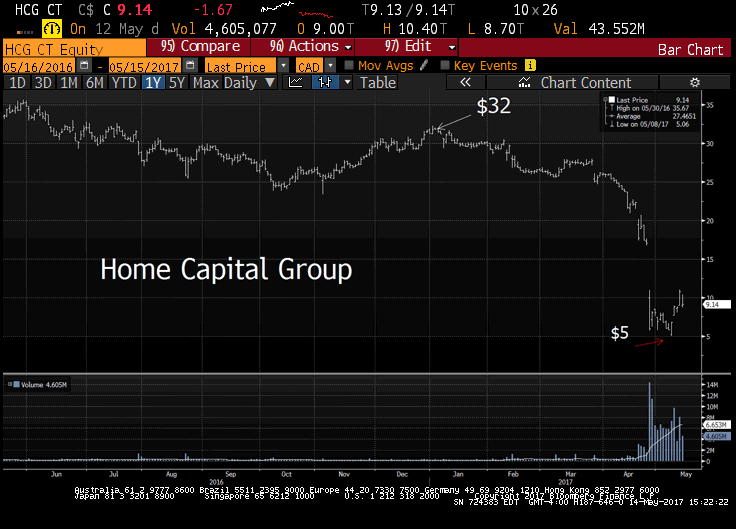Join our Larry McDonald on CNBC’s Trading Nation, Wednesday at 3:05pm ET
What’s Our List of Systemic Risk Indicators Saying now? Pick up our latest note here:
Don’t miss our next trade idea. Get on the Bear Traps Report Today, click hereBlog Updated May 20, 2017 at 4:10pm
Nominal Residential Property Prices
2007-2017
China: +155%
Canada: +82%
Australia: +74%
Norway: +72%
Sweden: +70%
USA: -4%
BIS Data, NY Fed
China’s impact on global property prices is colossal. Massive – debt build funded infrastructure spending pumped up commodity prices globally. Shadow banking leverage in China helped pump up commodity prices 2010-17. This had a substantial follow-on impact on Canada, Norway and Australia real estate prices (these countries are oil and materials rich). Likewise, $1T of currency outflows from China had to go somewhere, likely into real estate markets globally, hello Vancouver. Since 2007, U.S. real state prices are down slightly while property markets in some other G10 economies experienced no such downturn. The side effects of easy money central bank policies are visible here. Even with the global recession: prices, building activity, and mortgage credit continued to rise in fierce fashion. In several instances, the run-up has gone far enough that it has raised concerns about the broader consequences for economic and financial stability if real estate markets were to sour. While prices are extremely overvalued in several markets, there are also important differences across countries, and some important idiosyncratic factors to take into account. Bottom line; leverage, China and commodity prices have had a heavy hand in this disconnect.
A Look Back and a Look Forward
“Subprime is contained”
Federal Reserve’s Ben Bernanke, Spring of 2007
“Subprime is contained”
Bank of Canada’s Stephen Poloz, Spring of 2017
Almost ten years to the day, history is repeating itself – right in front of our very eyes. It was the spring of 2007, New Century had just gone bust. The subprime mortgage lender was the biggest story on Wall St., and when reporters finally got ahold of Federal Reserve Chairman Ben Bernanke, he did what all central bankers do on the eve of a credit crisis – try and keep investors calm.
“At this juncture, however, the impact on the broader economy and financial markets of the problems in the subprime market seems likely to be contained. In particular, mortgages to prime borrowers and fixed-rate mortgages to all classes of borrowers continue to perform well, with low rates of delinquency.”
Ben Bernanke, March 28, 2007
Ten years later, almost to the day – Central Bankers in Canada are singing Bernanke’s song. After Home Capital Group’s stunning collapse last month, investors have been told Mortgage lender’s problems won’t spread to other financial institutions. The Bank of Canada Governor Stephen Poloz told Globe & Mail in an interview this weekend. “Home Capital crisis is contained and doesn’t threaten broader market.”
In 2007, our Larry McDonald led a team at banking over $150m in profits betting against New Century and other subprime lenders. He has an entirely different perspective.
“The truth is very elusive as you’re heading toward that giant iceberg, the Captain wants those fannies in the seats. Believe half of what you see and none of what you hear.” McDonald said.
We believe the credit cycle has turned in North America, whether you’re looking at Mall Reits, credit card receivables, auto or student loans – defaults are spiking at an alarming rate. Fasten your seatbelts ladies and gentlemen.
“Risk is most dangerous when it is least apparent, and least dangerous when it is most apparent.”
Jim Grant
Canada’s Subprime Lending King
 Moody’s downgrade of Canada’s biggest banks beat down assets in a market already rattled by woes of mortgage lender Home Capital Group Inc. Yet, very similar to 2007 – most analysts say this isn’t evidence of an impending crisis. Investors are concerned that Home Capital’s troubles can lead to broader financial contagion, tipping Canada’s economy into the kind of crisis it averted in 2008.
Moody’s downgrade of Canada’s biggest banks beat down assets in a market already rattled by woes of mortgage lender Home Capital Group Inc. Yet, very similar to 2007 – most analysts say this isn’t evidence of an impending crisis. Investors are concerned that Home Capital’s troubles can lead to broader financial contagion, tipping Canada’s economy into the kind of crisis it averted in 2008.
What’s Our List of Systemic Risk Indicators Saying now? Pick up our latest note here:
Don’t miss our next trade idea. Get on the Bear Traps Report Today, click hereStill, home prices are at “the top of our list” of issues that could threaten Canada’s financial system, Poloz said. Poloz didn’t rule out the possibility of providing an emergency loan to Home Capital but stressed the need for a private solution to the co.’s issues.
Poloz trusts private system to continue stepping in to support Home Capital.
What’s Our List of Systemic Risk Indicators Saying now? Pick up our latest note here:
Don’t miss our next trade idea. Get on the Bear Traps Report Today, click hereHere’s Another Classic:



